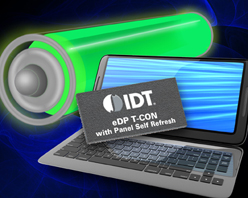Display controller saves power by buffering static images
Sep 14, 2011 — by LinuxDevices Staff — from the LinuxDevices Archive — 3 viewsIntegrated Display Technology (IDT) announced a display controller with integrated PSR (panel self-refresh) technology, claimed to offer significant power savings and “extended battery life.” The Embedded DisplayPort (eDP) 1.3-compatible timing controller works by storing static images in an integrated frame buffer, the company says.
Displays from Pixel Qi and E Ink cut system power consumption by eliminating (or at least reducing) the need for backlighting. But San Jose, Calif.-based IDF is showing off an alternative approach — called to our attention by an Engadget story — at this week's Intel Developer Forum (IDF).
IDT's solution calls not for a reduction in backlighting, nor for a change in display type. Rather, it works by finessing the power draw of a system's display controller.
 According to IDT, its Embedded DisplayPort (eDP) 1.3-compliant timing controller (TCON) achieves its economies by identifying static images, then storing them locally in an integrated frame buffer. It then displays the images "seamlessly," while allowing a device's main eDP link and GPU (graphics processor unit) to be mostly powered down, the company adds.
According to IDT, its Embedded DisplayPort (eDP) 1.3-compliant timing controller (TCON) achieves its economies by identifying static images, then storing them locally in an integrated frame buffer. It then displays the images "seamlessly," while allowing a device's main eDP link and GPU (graphics processor unit) to be mostly powered down, the company adds.
The result of this PSR technology is "significant system-level power savings and extended battery life in portable applications," according to the company. IDT adds that VESA eDP v1.3 solutions inherently offer lower system cost and better battery life than the LVDS (Low-Voltage Differential Signaling) solutions typically used in portable embedded display applications.
Left unstated by IDT — but implicit — is that its technology could do little or nothing to save energy during gaming, video playback, or other applications where images are constantly changing. Still, PSR could be particularly useful in embedded devices that display unchanging (or largely identical) images for an extended period, ATMs being one example.
Further information
More information on IDT's family of display-related products may be found on the company's website.
Jonathan Angel can be reached at [email protected] and followed at www.twitter.com/gadgetsense.
This article was originally published on LinuxDevices.com and has been donated to the open source community by QuinStreet Inc. Please visit LinuxToday.com for up-to-date news and articles about Linux and open source.